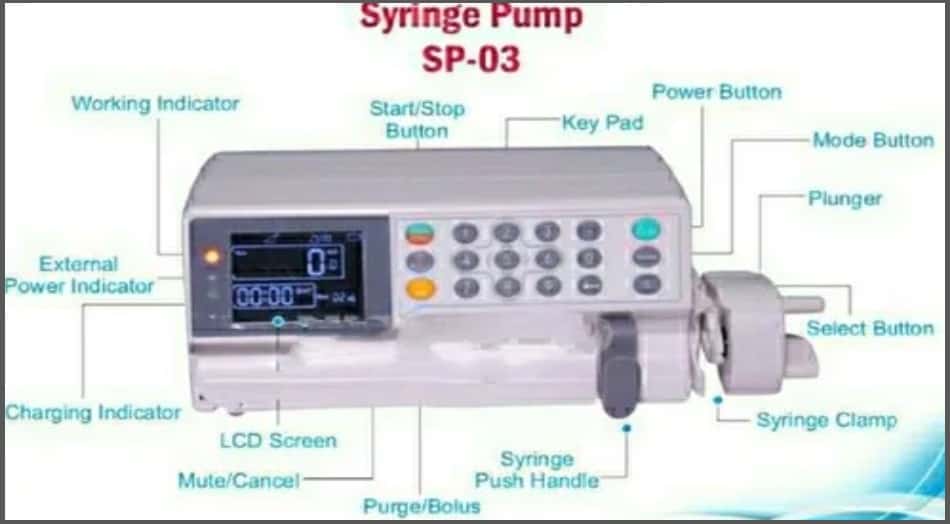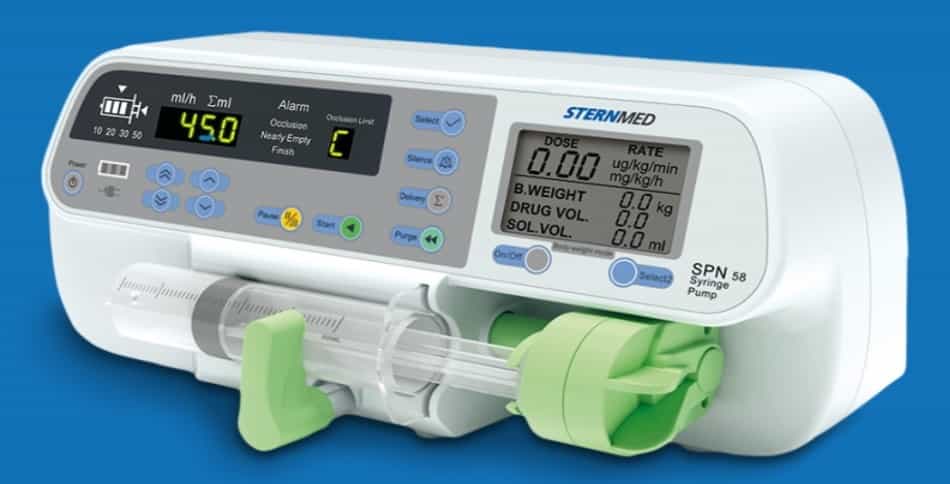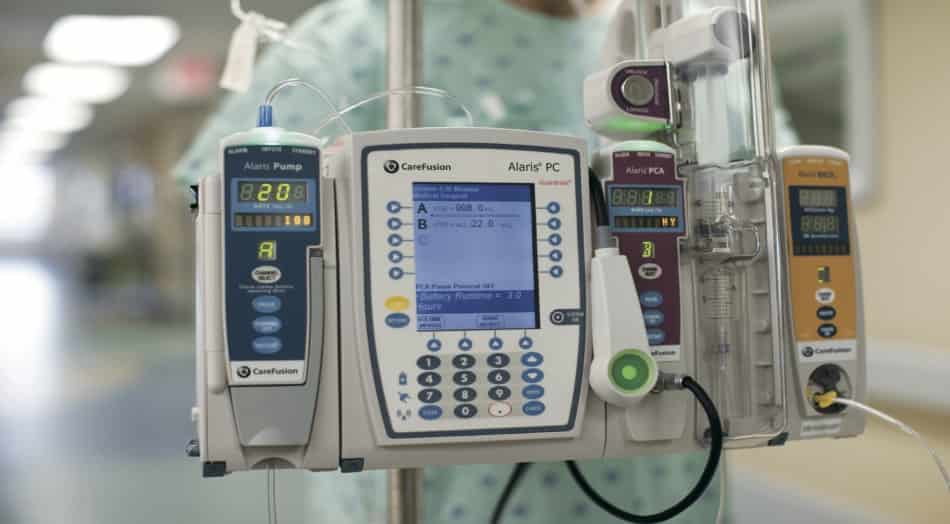In this article, we will learn all about infusion pumps, definitions, parts, working principle, types, applications, etc. Let’s explore!
What are Infusion Pumps? Definition
Infusion Pumps Basics
Today, the world is increasingly interested in robotics and its applications in various fields, such as medicine. Improving accuracy, increasing operating speed, and reducing costs Are’s top performance goals for improving the design and manufacture of equipment or robots. One of the best ways to achieve these goals is to use teams of robots rather than human resources. Infusion pumps have been used in hospitals since the late 1960s.

- The infusion pump that we designed and manufactured in this work is a robot that has applications in doctors and healthcare facilities.
- This device is used for patients who cannot receive food and medicine by mouth.
- These gadgets deliver medication and nourishment in precise doses.
- These devices are available for treatment in all medical facilities, and they are operated by trained medical personnel who know how to set the length and rate of fluid supply.
- Because they can give fluids at specific frequencies, quantities, and intervals, infusion pumps are superior to manual fluid administration pumps.
- These pumps can be used to administer pain medicines, chemotherapeutic treatments, antibiotics, and insulin, among other medications but the rate of the infusion pump must be programmed with the software.
This blog discusses the many types of infusion pumps and their distinguishing features, so let’s begin!
Infusion Pumps Definition
Infusion pumps first appeared in heart surgery and pediatric procedures. Anesthesia-specific pumps first appeared over 15 years ago, despite the fact that anesthesia is a modest business opportunity. An infusion pump is a type of pump (syringe, peristaltic, and others) used to distribute fluids in a medical setting; these devices are typically used to manage nutrients and medications.
- Infusion pumps can supply large or little amounts of fluids, and they can be used to deliver nutrition or pharmaceuticals like insulin or other hormones, antibiotics, chemotherapeutic drugs, and pain relievers.
- Some infusion pumps are intended for usage at the patient’s bedside only. For example, ambulatory infusion pumps are meant to be portable or wearing.
- The rate of flow is controlled by an infusion pump, which takes fluid from a typical bag of intravenous fluid.
- It delivers precise and ongoing therapy. An infusion pump may give fluids at either a very slow or very fast rate since it can use any size bag of intravenous fluid.
- Some infusion pumps can only control one intravenous line, while others have three pumps packed into one device.
- To reduce space, these “triple pumps” are utilized.
Parts of Infusion Pumps
The following are the key components of an infusion pump:

- Power supply system: Always check the voltage compatibility (110 or 220 V, including considering whether it is AC or DC) when using a rechargeable battery or plugged into an external source; otherwise, connect to an appropriate transformer. To minimize overloads, you can alternatively connect to a voltage stabilizer.
- Ultrasonic air detector: A device that uses ultrasound to detect vacuum or air bubbles in a system.
- Detachable Peristaltic pump: The peristaltic pump is detachable, making maintenance and cleaning a breeze.
- Door Lock: A safety anti-opening door that is used to prevent the substance or medication from being removed from the apparatus while it is infusing.
- Pressure Adjustment: The infusion pressure is adjusted based on personal help.
- Pressure Indicator: Displays the infusion pressure, as measured during the adjustment.
- Bolus: It allows you to plan the delivery of a certain amount of medication or substance at a specific time.
- Number Lock: This feature prevents unauthorized changes to the infusion settings.
- SMS Alarm: Display some messages or alarms to determine if there is a problem with the machine.
- Infusion volume (preset): Display the volume to infuse
A few additional items shall be kept in mind:
- Drop/Flow Rate: Display the rate at which the drug is infused.
- Audible & Visible Alarm: Display some messages or alarms to determine if there is a problem with the machine using a sound speaker and LEDs.
- Alarms: The most common infusion pumps include both visible and audible alarms that allow them to identify any problem during operation.
- Drip Alarm: When the drip chamber detects an increase or decrease in the planned flow, the drip alarm is activated.
- Air Alarm: The sensor detects the presence of air inside the infusion tube and sounds an alarm.
- Electrical network disconnection Alarm: When equipment is unplugged from the electrical network and begins to function on batteries, an alert is triggered.
- Allocation by occlusion: The system detects an obstacle between the pump and the patient and allocates by occlusion.

- 2.8" TFT LCD display, high-precision infusion control, compatible with a variety of intravenous infusion sets to ensure the best results.
- Two kinds of power supply, suitable for a variety of scenarios: external DC power supply / built-in 5000mAh large-capacity lithium battery.
- A reminder and alarm system covering almost the entire process: reminder when the infusion is turned on, the pump door opens during the infusion, there is a bubble reminder in the infusion set, the reminder when the infusion ends, the KVO state reminder, the battery reminder, etc.
- A.B.S——ANTI BOLUS system prevents instantaneous high-dose injection when the sudden blockage disappears, and the enclosed IV-set clip prevents the liquid from flowing freely when the pump door is accidentally opened.
- The remaining infusion time can be displayed during the infusion process, and the infusion parameters can be saved after the power is off.
How Does Infusion Pumps Work?
The Infusion Pump employs a quasi-peristaltic blend of these two approaches.

- The pumping mechanism operates on each of the three chambers, in turn, using a three-chambered cassette.
- The user can specify the fluid delivery rate in milliliters per hour (ml/hr) as well as the fluid volume to be given in milliliters (ml).
- To protect the patient, the pump will not provide fluid above a specified delivery pressure.
- This is accomplished by monitoring the pressure in the providing set and ensuring that it does not reach a certain level. If the pressure is surpassed, the pump will stop and an alarm will ring to notify the user. An occlusion alarm flow is a name for this type of alarm (Restriction of flow).
- The pump’s function is continuously monitored, and an alarm sound will avert any potential harm to the patient, such as failure to distribute fluid in the usual manner.
- The infusion pump has a battery backup so it can keep working even if the power goes out.
Procedure of Infusion Pumps
- Perform a thorough examination of the patient and keep track of their vital signs.
- Examine whether the patient satisfies the protocol’s requirements.
- To use any protocol, make sure there are no restrictions.
- The drug or IV fluid to be infused will be drawn up by hospital professionals, who will also check that the infusion pump is working properly.
- Prior to transport, EMS staff will verify the following: – The physician’s written and signed infusion order and there is adequate medication in the infusion pump for the anticipated transport time.
- The infusion tubing is appropriately linked to the patient’s intravenous line’s three-way stop clock.
- Heparin can be infused via a syringe pump at some institutions instead of being piggybacked into a running intravenous line.
- It is necessary to monitor the pace of infusion pump delivery. Also, it’s necessary to double-check the amount of infusion that’s already been given.
- If an alarm sounds during transport, the attendant should try to resolve the issue.
- The alarm display message will go away if the problem is fixed.
- If the problem cannot be resolved, the attendant should switch off the infusion by pressing the start/stop button.
Safety Features for Infusion Pumps
Because medical devices such as infusion pumps are used on patients who are likely to be in a critical condition, their dependability is vital. As a result, they frequently include warnings and alerts. Many of the safety safeguards found in infusion devices are particularly vulnerable to component and assembly process tolerance variations.

Because of the potential for adverse outcomes in the field, there is a strong regulatory focus on their design. Safety features are a primary driving force behind the design of infusion pumps, as they manage every element of a user’s engagement with the device and have the potential to render it unusable if something goes wrong.
- In the administrative set, there should be an anti-free-flow device.
- When the door is opened, the free-flow clamp in the pump is released (volumetric pump only)
- Air-in-line detection (volumetric pump only)
- Detection of an empty drug/fluid reservoir
- Detection of occlusions
- Protection against unintentional occlusions by modification of settings.
- Two different and/or simultaneous actions to commence bolus
- Two distinct and/or simultaneous actions to modify the pace
- Alarm for a syringe barrel clamp, a door open alarm, or anything similar
- Disengagement alert for syringe plungers or equivalent
- Pre-set control of total volume to be injected and digital read-out of volume infused.
- At the end of the infusion, an automatic switch to keep the vein open (KVO) rate is initiated.
- Back-up of the patient’s medical history and technological history.
- Back-up battery (automatic switching to the battery when mains power fails)
Types of Infusion Pumps
The infusion pump is divided into several groups. Infusion pumps can be divided into several classes based on a variety of variables. However, there are three distinct types of infusion pumps. The following are the different types of infusion pumps:
Infusion pumps classified by function
There are two types of infusion pumps when it comes to using. Specialty pumps and regular pumps are examples of these.
Specialty Pumps
Specialty infusion pumps are created to meet the demands of certain medical situations. They are frequently utilized in the delivery of home care or the treatment of certain illnesses such as diabetes. The followings are the three main classifications of pumps in the specialty infusion pump category,
- Implantable Pumps,
- Enteral Pumps, and
- Insulin Infusion pumps
Traditional Infusion Pumps
Traditional infusion pumps can be used in medical settings such as mobile, home, and long-term care. These pumps can be used to give pain medication, antibiotics, chemotherapeutic medication, and hydration fluids in both fixed and mobile settings. Traditional infusion pumps are further classified into three types:
- Syringe infusion pumps
- Disposable pumps
- Large volume pumps
- Elastomeric pumps
Fluid Volume Delivery Categorization of Infusion Pump
Infusion pumps are divided into two groups based on the volume of infusions they deliver:
Syringe pumps or small volume infusion pumps
These are infusion pumps that administer little amounts of medication in a small amount of time. These are frequently used on newborns and young children. These infusion pumps are perfect for delivering little amounts of medication, such as hormones, through a controlled motor mechanism that uses a plunger-style pumping device. Some pros and cons of syringe pumps are as below:
- The drugs are delivered in a precise volume by the syringe pumps.
- These have a lot of potential for spread.
- Syringe pump may be easily placed on a desk.
- The pump results in very modest flow pulsation and it is little in size.
- The syringe pump can only deliver a small volume of fluid into the patient’s body and it comes with a minimal disposable.
- However, it isn’t capable of delivering a big number of drugs.
- Also, it does not have the most up-to-date technologies, such as an alarm system, as LVP does.
Large volume pumps (LVPs)
The LVPs are infusion pumps that deliver enormous amounts of nutrition or medication. Electronic peristaltic pumps are frequently used by LVPs. The pump can be operated manually or by a computer-controlled roller. Some pros and cons are as follow:
- Large Volume Pumps are capable of delivering a wide range of drugs.
- LVP is equipped with cutting-edge technology, such as an alarm system. This alarm will start ringing if something goes wrong.
- It requires a lot of areas to set up and is rather enormous.
Infusion Pump Classified by their Mobility
Ambulatory infusion pumps (AIP)
Ambulatory infusion pumps are small, lightweight infusion pumps that are commonly used to treat persons with chronic illnesses. Because they require medication throughout the day, patients with debilitating diseases may need to move around with their medical infusions.
- Such patients can be transferred while still receiving their medication thanks to mobile and lightweight infusion pumps.
- This type of portable infusion pump overcomes the difficulty of administering medicinal infusions while on the go.
Stationary infusion pumps
Because stationary infusion pumps do not require movement, they do not need to be as small and light as portable infusion pumps.
- Patients with chronic illnesses who are confined to their beds typically require pharmaceutical or food infusions.
- For patients who require frequent bedside feeding or medicine, the stationary pumps offer IV infusions at their bedside.
Advantages of Infusion Pumps
The advantages of infusion pump are as follows,
- The syringe pump is fast and easy to use. The syringe pump allows the user to define the total volume of fluid and deliver it at a precise rate.
- A high-pressure syringe pump can set target pressure or constant pressure control to run experiments.
- Even though the resistance is variable in the experiment, the average flow rate of the liquid in the syringe pump remains constant.
- These pumps have an alarm system when there is a problem.
- Infusion heating
- Low irritation
- The infusion pump has a high flow rate.
- It is more likely to sound an alarm of acupuncture.
Disadvantages of Infusion Pump
The disadvantages of infusion pump are as follows,
- The volume of the syringe used, limits the volume of liquid dispensed.
- Excessive resistance can lead to pressure build-up and eventual failure of the
- Without a flow sensor, it is impossible to know the flow rate during transients.
- Certain types of infusion pumps are expensive
- Battery is problematic
- This pump needs battery power
- Professionally trained personnel are required to operate this pump
- Personnel training is required.
- In some cases, infusion pumps can cause infections
Applications of Infusion Pump
Let’s see the application of infusion pump,
- These pumps are used for cancer treatment during chemotherapy
- They are used to inject different drugs in pharmacies.
- These pumps are used to inject various nutrients or drugs into patients.
- Improve patient safety by improving accuracy and reliability and consistency, also for pain management
- Infusion pumps are employed in more than just standard hospital settings; they’re used in a variety of medical industries. This Smart technology is frequently used in nursing homes, for example. Some patients may be able to utilize the gadgets at home.
Conclusion
In today’s date, Infusion pumps are used in hospitals and other medical institutions around the world. Infusion pumps have made a huge difference in patient care, but they are not without their flaws. The FDA (Food and Drug Administration) adopts a balanced approach to public health, aiming to promote the benefits of infusion pumps while minimizing the hazards associated with them.
Through the infusion pump improvement plan, the FDA will work hard to formulate additional requirements for infusion pump manufacturers, actively promote equipment improvements, and increase user awareness to solve infusion pump problems. Thus, to conclude the improvements in design, structure, and working in near future will definitely lead to more usage of the Infusion pump.
Check out to our a few interesting articles,
Reference Articles


